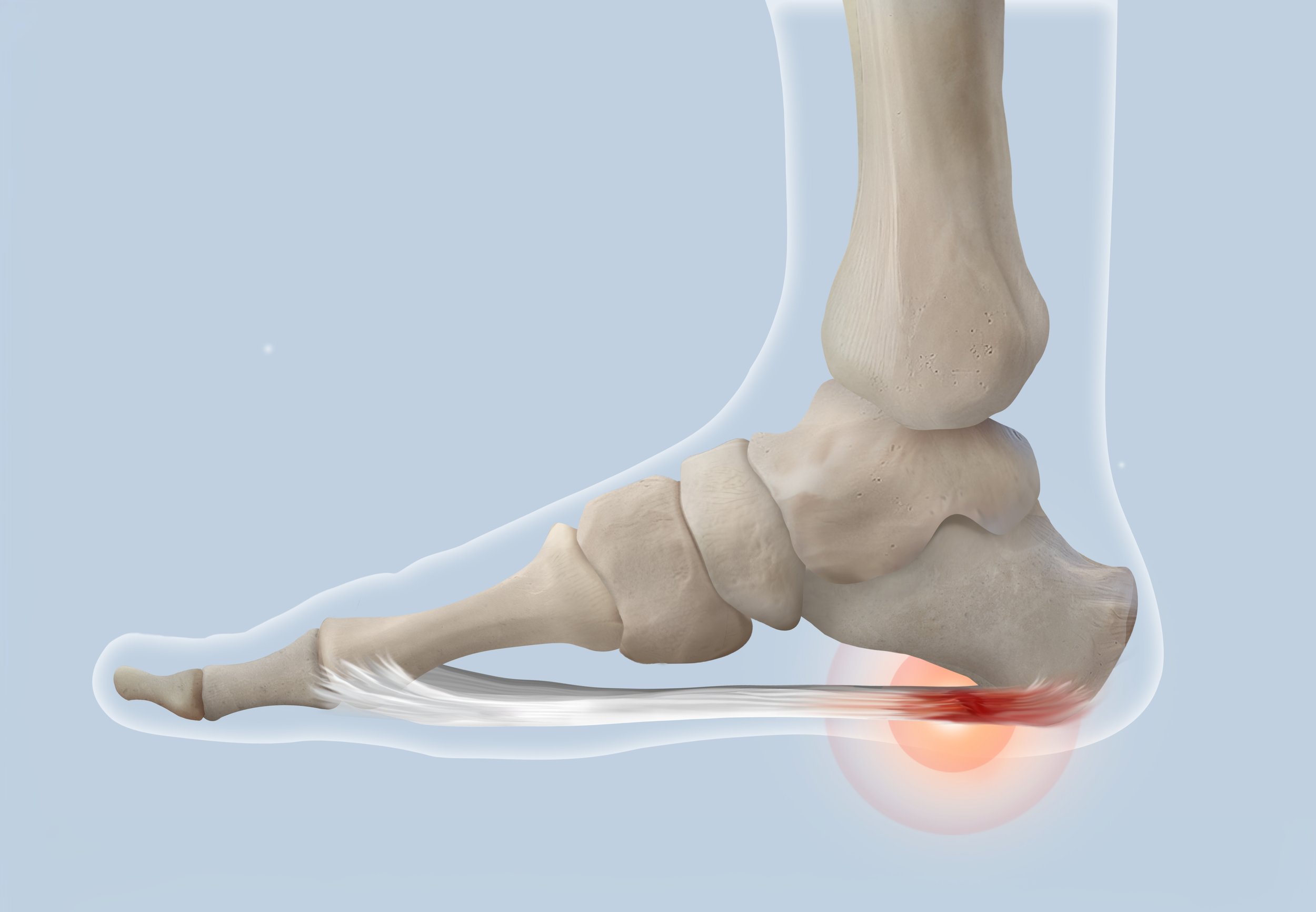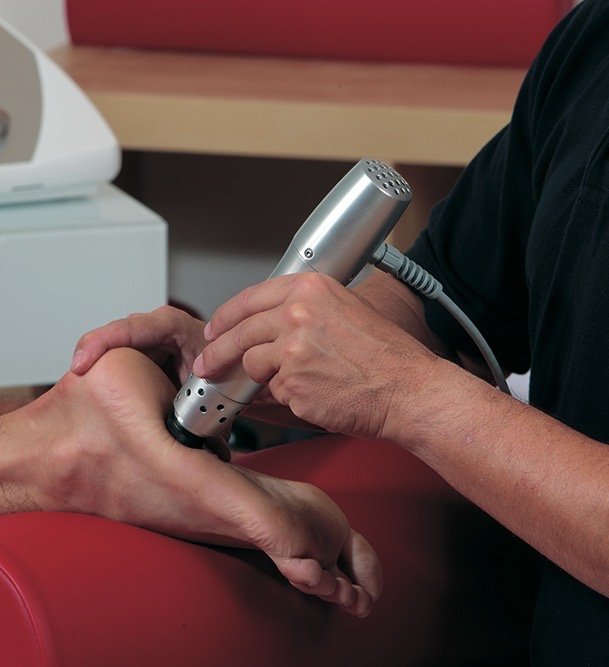Everything You Need to Know About Plantar Fasciitis—A Podiatrist Explains Plantar Fasciitis Symptoms, Causes, Treatment Options, and More
Foot pain can stop you in your tracks and put a damper on your day.
That morning run you’d planned?—raincheck.
The game of pickleball?—on hold.
Dance class?—delayed.
When plantar fasciitis takes hold, it calls the shots. Suddenly, even walking to work or taking the dog for a stroll in the park feels impossible.
You’re in pain, and every step reminds you of it.
Just because plantar fasciitis is common doesn't diminish its impact on your daily life and activities when it flares up.
It may be tough to spell, but it’s even tougher to live with.
At City Step Podiatry, we believe in arming you with the knowledge and resources you need to understand, prevent, and treat foot issues like plantar fasciitis.
That’s why we’re laying out everything you need to know about this condition in this helpful blog.
In it, you’ll learn common causes of plantar fasciitis, as well as how to treat it and prevent it from occurring.
Ready to get moving to stay moving—pain free? Read on!
What is plantar fasciitis?
To understand what plantar fasciitis is and how it happens, we first need to dive into some basic foot anatomy.
Fascia is a term that comes from the Latin word, meaning "a band, bandage, swathe, ribbon."
In your body, fascia is the essential connective tissue that holds everything together and allows you to move. Your fascia surrounds and supports your body’s internal structures, helping them do what they do.
When your fascia is healthy, it bends, flexes, and stretches along with you.
When it’s not, it can restrict your movement and even cause pain.
Your plantar fascia is the thick band of tissue that runs from your heel to your toes along the bottom of your foot.
Its functions are vital to your ability to stand and move. Your plantar fascia are tasked with supporting your arches and providing shock absorption. This is essential to be able to stand, walk, run, jump, dance—and do it all without pain or injury.
Your plantar fascia are foundational to your foot health and functions—which make them essential to your whole body and your ability to lead an independent, active life.
What causes plantar fasciitis?
Like anybody with a big, taxing job, your plantar fascia sometimes become overworked and overstressed.
This can lead to overuse, overstretching, and inflammation. And that is the triumvirate that leads to plantar fasciitis.
If you’re a student of biology, medicine, or etymology, you probably already recognize where this is going.
The suffix -itis indicates inflammation. Plantar fasciitis, therefore, involves inflammation of the plantar fascia.
But what causes your plantar fascia to become inflamed?
In most cases, plantar fasciitis is the result of overuse and overstretching of his ligament, which causes it to become inflamed.
Heel spurs can also contribute to plantar fasciitis. Unclear about this issue? Check out our recent blog, all about heel and ankle spurs.
Some folks are predisposed to developing plantar fasciitis due to the way their feet are shaped and structured.
Others are at increased risk for it because of their lifestyle, choices, and individual anatomy and physiology.
You’re at increased risk for plantar fasciitis if you:
Are active and regularly participate in higher-impact sports like running and dancing
Are overweight
Work a job that requires you to spend long hours on your feet
Have tight Achilles tendons
Are over 40
Have flat feet or very high arches
Choose footwear that doesn’t offer sufficient arch support or have soft soles
Regularly go barefoot
Folks with medical conditions that impact the joints, such as lupus and rheumatoid arthritis, are also at higher risk for developing plantar fasciitis.
Next, let’s outline the common symptoms of plantar fasciitis to help you recognize it if it shows up.
Symptoms of plantar fasciitis
Plantar fasciitis is a common foot condition, impacting around 10% of the population. It’s most common in folks between the ages of 40 and 60.
Typical plantar fasciitis symptoms include:
Heel pain
Pain in the arches of your feet
Swelling in and around your heels
Foot stiffness and reduced range of motion
Tightness in your Achilles tendon
An aching or burning sensation in the bottom of your foot
Sharp, stabbing, or dull pain in the bottom of your foot
Because of its location, plantar fasciitis is usually felt most when you’re standing and walking, due to the downward pressure on your feet. It’s often worse in the mornings when you take your first steps, or when you begin walking again following a period of rest.
Now that you know what it feels like, let’s explore how plantar fasciitis is diagnosed and treated.
How is plantar fasciitis treated?
In many instances, you may be able to accurately diagnose your plantar fasciitis. Still, it’s important to get a professional opinion, to rule out any similar issues and ensure you’re pursuing the appropriate course of treatment.
Other issues can cause heel pain, so reach out to your trusted podiatrist to help you determine the exact underlying cause of yours.
Your podiatrist will learn about your pain, how long you’ve been experiencing symptoms, and for how long. They’ll also perform a physical exam to assess your feet and ankles and may also order imaging tests, like an x-ray, ultrasound, or MRI.
When your podiatrist is certain you’re dealing with plantar fasciitis, they’ll help you decide on the right course of treatment.
Treatment approaches for plantar fasciitis include:
Icing and rest
Taking OTC anti-inflammatories, like Advil
Massage and stretching (under a professional's guidance)
Physical therapy
Wearing a boot cast for temporary immobilization to promote healing
Changing your footwear
Donning a night splint
Lifestyle modifications to temporarily reduce walking
Steroid shots or injections into the heel
Surgery (in rare cases)
You’ll be happy to learn City Step Podiatry also offers several cutting-edge treatment approaches for plantar fasciitis. We always strive to lead the charge in offering you the effective, evidence-based podiatry treatments you deserve.
Custom orthotic inserts
Custom orthotic inserts are often recommended to address plantar fasciitis. These are molded to fit your feet, and can be inserted into any type of closed-toe shoe—to create your perfect pair.
Custom orthotics can give your feet and ankles the support they need, reduce stress and strain on your ligaments, and even improve your gait. They can help you recover from plantar fasciitis and reduce its risk of returning!
Radial Shockwave Therapy
City Step Podiatry also offers Radial Shockwave Therapy in our office. This cutting-edge therapy is proven effective for a variety of foot and ankle issues, including plantar fasciitis.
The best parts of Radial Shockwave Therapy (RSWT) are that it’s:
Fast—treatments typically last around 5 minutes, meaning you can easily pop in on your lunchbreak or before or after work to easily promote your healing.
Effective—this approach has been proven as or more effective than other common treatment modalities.
Results-driven—many patients experience results and noticeable pain relief immediately following their first treatment.
Non-invasive—RSWT doesn't affect your usual routine at all. You can resume your normal activities immediately after your treatment.
Remy class IV laser therapy treatments
Who knew lasers were used in podiatry? We did! City Step Podiatry always seeks to innovate and evolve to meet our patients’ needs. That means offering the latest and greatest treatment modalities to you.
Our state-of-the-art Remy laser therapy treatments can combat plantar fasciitis symptoms and promote healing. This safe, effective treatment is proven to reduce inflammation, pain, and discomfort caused by a variety of foot and ankle conditions.
This innovative approach delivers treatments that are quick, effective, and even soothing! Many patients experience fast relief from their symptoms and report that the laser treatments feel warm and comforting.
The Remy class IV laser therapy system helps to enhance circulation and encourage cellular repair.
Reach out anytime to learn more about this innovative approach and schedule your consultation to help determine if it’s right for you. We’ll customize your treatment plans to meet your unique therapeutic goals and needs.
Interested in exploring custom orthotics, Radial Shockwave Therapy, or Remy class IV laser therapy for your plantar fasciitis? Dr. Young will be happy to answer your questions and help you determine if one of these treatment approaches is right for you. Then, we can get you scheduled to start as soon as possible, right in our office.
Can plantar fasciitis be prevented?
Many of the treatment modalities we mentioned above can aid in preventing plantar fasciitis from returning.
In addition, there are a few lifestyle tweaks you can consider and implement to help reduce your risk of plantar fasciitis returning.
These include:
Building in time to stretch before and after a run or high-impact workout
Adding recovery time after intense workouts to allow your feet to rest
Choosing and wearing supportive footwear that fits you well
Avoid going barefoot, especially on hard surfaces (psst—learn more about why and discover the truth behind several common podiatry myths in our helpful blog)
Another great way to stay on the preventive side of foot issues like plantar fasciitis is to keep in close contact with a trusted podiatrist.
Dr. Young has extensive knowledge and experience assessing and treating foot and ankle conditions of all kinds. Her personalized approach and array of treatment modalities offer you the customized care you’re seeking, while our convenient downtown Chicago office location makes it easy for you to get the podiatry services you need. Online booking and flexible scheduling mean you never need to wait or reorganize your schedule to get the comprehensive podiatry care you deserve.
Keep a close eye on our blog for informative articles made to keep you moving, and sign up for our monthly newsletter to stay up to date on all things City Step!
City Step Podiatry is here for you! Reach out today to schedule your visit and treat your feet to the care they deserve.









